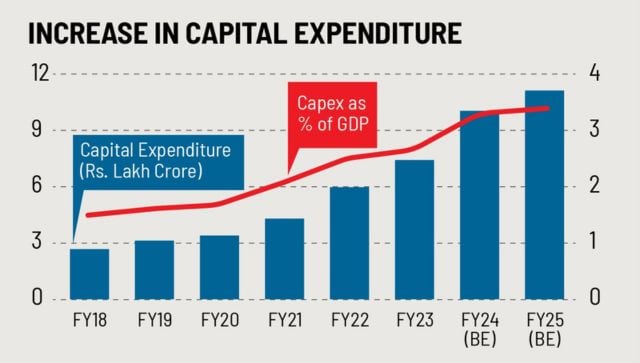Budgets are not supposed to say much. They are, after all, just statements of account of a country – how the government plans to mobilise resources and spend them. Yet, India’s annual budget is the most awaited government document every year.
That is because budgets do say a lot, not just to the country’s own citizens but to the world outside – even when they have nothing much to offer. Sometimes what is not said matters as much, if not more, than what is said. That is true about the interim budget presented on Thursday. Here’s a look at the message behind the numbers and words of Budget 2024.
This is an election year: That is why it was an ‘interim’ budget. The full budget comes after elections in April-May this year when the new government will be sworn in. That is also the reason Finance Minister Nirmala Sitharaman’s budget speech spent more time recounting what the Narendra Modi government has done in its last two terms than what it plans to do in the year ahead.
… and the government is confident: A pre-election budget, which is supposed to be just a vote-on-account shorn of any big announcements, can sometimes be the most difficult balancing act for finance ministers. Poll calculations can upset budget maths as freebies, populism, welfare schemes, come into the picture.
This is especially true when the ruling dispensation is unsure of which way the political wind is blowing. So, India has had interim budgets that paid extra attention to potential voters. The one in 2009, for instance, tweaked income tax slabs, the one presented in 2019 announced cash handout to farmers and pushed up the lowest income tax limit.
The absence of any freebies, on the other hand, points to the government’s confidence about the coming elections. In fact, the finance minister asserted in her budget speech that she would deliver a roadmap for a developed India (Viksit Bharat) in the full budget after the polls.
Welfare still rules: Welfare schemes for farmers, women and housing for the poor have been part of the Modi government’s political narrative in the last couple of years, and this budget ensured it stays that way. The finance minister not only weaved her budget speech around four social groups of women, poor, farmers, and youth, but also kept some of the biggest allocations and increases for the group.
The rural employment scheme Mahatma Gandhi National Rural Employment Guarantee Scheme (MNREGA) saw its allocation hiked significantly, the construction of over 40 million houses in villages and cities was a highlight, the finance minister talked about making 30 million ‘lakhpatis’ among women (Rs 1 lakh = Rs 100,000) and enhanced the coverage of the health insurance scheme for the poor, among other measures.
… but it is also about the economy: “We are working to make India a ‘Viksit Bharat’ (developed country) by 2047. For achieving that goal, we need to improve people’s capability and empower them,” Finance Minister Sitharaman said in her budget speech. “The saturation approach of covering all eligible people is the true and comprehensive achievement of social justice. This is secularism in action, reduces corruption, and prevents nepotism,” she added.
India is still on a tight budget: While the talk was big on welfare, it was also a fiscally conservative budget that prioritises long-term prudence over short-term populism and aims at improving India’s fiscal deficit. The government’s planned capital expenditure, which saw an increase of over 37% in the previous financial year, is budgeted to increase by just over 11% in the next year.
Taxes have remained unchanged while major subsidies on food, fuel and fertiliser are 8% lower. This, along with the absence of big spending on welfare, will help the government bring down the fiscal deficit to 5.1% from 5.8% for the current year.
This fiscal consolidation will make India’s case for improvement in sovereign credit ratings stronger. Gross government borrowings will also be lower, which means availability of more credit to the private sector.
… but Indians are getting better at paying taxes: In the last 10 years, India’s direct tax collections have more than trebled and the number of people filing income tax returns has gone up 2.4 times. That is big, given that less than 5% Indians pay income tax. While rising income is one reason behind this, rationalisation of tax rates has helped too.
Under the new tax scheme, there is now no tax liability for taxpayers with income up to Rs 700,000 a year. That figure was just Rs 220,000 in 2013-14. Corporate tax rate has also gone down from 30% to 22%. Ease of filing tax returns and getting refunds have reduced paperwork considerably. Income tax forms come with prefilled information and the average time to process returns has gone down from 93 days in 2013-14 to a mere ten days this year.
The overhaul of the indirect tax regime by introduction of Goods and Services Tax (GST) has reduced the compliance burden on trade and industry. The tax base of GST more than doubled and the average monthly gross GST collection has almost doubled this year. All this not only helps the finance minister in her budget planning but also makes it easier to give back to taxpayers.
Come ‘develop India’, and see India develop: India saw a foreign direct investment (FDI) inflow of $ 596 billion between 2014 and 2023, twice the inflow during 2005 to 14 and now plans to encourage more. But India is also negotiating bilateral investment treaties with its foreign partners in the spirit of ‘first develop India’, the government said.
Not just investments, presenting India’s sixty G20 meeting locations to the world was about showing the diversity that India has to offer. The plan now is to develop, brand and market India’s iconic tourist centres and rate them based on the quality of facilities and services to make it easier for the globetrotters.
Link to article –





